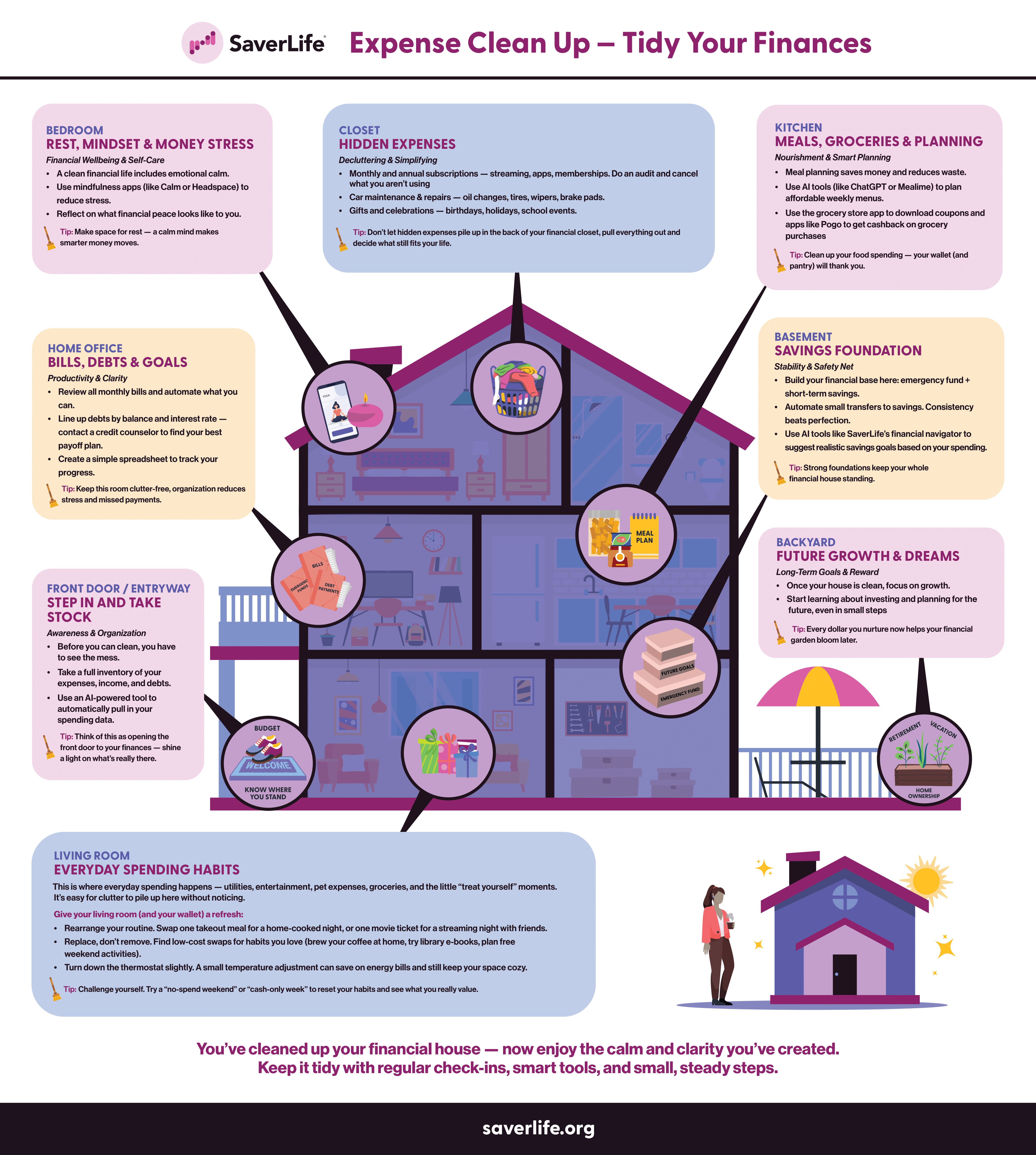
Do you need help saving money?
Let’s go back to 2019, a year before COVID-19 hit.
Maybe you’re excited about travel plans, graduation parties, or concerts coming up this year. All of a sudden, COVID-19 changes all of your plans. You might’ve lost your job, had to drop out of school, or help your family with medical treatment. Maybe it all happened at once, and you realized that you had little saved up for something so devastating.
This pandemic showed us the importance of saving and having a plan for the worst-case scenario.
Now that we’re coming back to pre-Covid day-to-day, we can start to save again. Saving money can help you create a vibrant financial future. However, trying to save money can seem overwhelming when you’re stuck under a massive mountain of debt or living paycheck to paycheck.
Really, though, saving can be simple.
Taking small steps to create a saving plan can get the ball rolling on a future committed to saving. One simple way to start is by creating a money-saving chart.
What the heck is a money-saving chart?
Make a money-saving chart if you need a little help reaching your financial objectives. It’s a powerful visual aid that’ll motivate you to save.
You probably have a zillion things you want to save for, but often, they feel out of reach. A money-saving chart takes them out of the realm of the impossible and makes them doable.
Making a money-saving chart is really simple.
You can make it digitally with a spreadsheet or calendar, or use paper and pencil if that’s what you prefer!
Start by deciding how much you want to save, and split it across a calendar. Then, write down the amount of cash you need to save each week in a box, rectangle, or oval. After depositing the called-for amount, color in the box.
With a money-saving chart, you’re only limited by your creativity.
Money-saving charts are 100% customizable, so you create whatever kind of chart you think will best help accomplish your goal.
How to create a money-saving chart
Step one: set your goal
Pick a reason to save. Here are a few ideas:
- Emergency fund
- Dream vacation or wedding
- Slush fund
- Down payment for a house or automobile
- Large purchases such as a computer or camera
- House renovations
- Car repairs
- College fund
Step two: decide how much to save each month
Decide precisely how much you need, and determine the date that you need to save up for. Pick a doable amount of money for the allotted time to avoid feeling stressed out or overwhelmed.
Step three: create your chart
To create your money-saving chart, you can use online templates or make your own. There are a lot of ideas online if you can’t think of anything.
You can keep this simple or get as creative as you want. It may be fun to turn it into an extravagant board that you put up, so once you have a design in mind, gather your stickers, colored pens, paper, and glitter, and go to town!
Keep your brand-new chart where you’ll see it every day, such as on the fridge, a pantry door, a bookcase, or your bedroom wall. This will help to motivate you to reach your savings goal.
6 ideas for creating money-saving charts
1. 52-week savings challenge
The 52-week savings challenge is a fun way to boost your financial self-discipline. Start by saving $1 the first week, and add a dollar to each subsequent week’s total.
For example, by week two, you’ll save $2, week three, $3, and so on until you get to week 52. If you follow this simple money-saving chart, you’ll save $1,378 in just a year! This savings plan is perfect for bulking up your emergency fund or if you have a big purchase you want to make at the end of the year.
To create this chart, draw four columns. In the first one, write down the date of each Sunday in the year. In the second column, write how much you’ll be depositing. In the third column, write the word “extra.” This column is for putting additional money into your fund.
Once you make a deposit, circle the appropriate amount. If you sock away extra money, write in this amount too.
Do it with a partner to make the 52-week challenge even more fun and to keep each other accountable.
2. Emergency fund
An emergency fund is an important part of feeling financially stable. It can be a lifesaver when big, unexpected expenses roll around. Though we don’t like to think about it, you never know when you may lose your job, become too sick to work, or need to cover a major car or home repair.
Try to have three to six months of living expenses in this account.
To create a money-saving chart for this goal, write down your savings objective followed by the words “EMERGENCY FUND” on the top line of the chart.
On the second line, write down your starting balance. Underneath these lines, draw 100 boxes with “$10” written down in each one.
Every time you make a $10 deposit in this account, color in one of the boxes.
3. $10,000 savings challenge
If you want to challenge yourself, try saving $10,000 in a single year.
To accomplish this ambitious goal, it helps to not only incorporate excellent financial habits into your everyday life but also have a way to see your progress.
Since you’ll need to save $833.33 every month, create a chart with twelve boxes. In each box, write $850, which will be enough to cover this amount and a little extra. Once you save that amount each month, color it in the box.
4. House down payment
Many Americans dream of owning a home. With rising housing prices and interest rates, it can be especially difficult to know how to start. Saving for a downpayment is a great place to start and can be easy to do with a money-saving chart.
Think about how much you can spend on a monthly mortgage. Your downpayment should be 5% to 20% of the purchase price.
So, let’s say you’re planning on buying a home that costs $225,000. In that case, you’ll need to save between $11,250 and $45,000. A higher downpayment means a lower monthly mortgage, so we’ll aim for something in the middle with $20,000 as our down payment amount.
If you break this down over five years, you’ll need to save approximately $333 monthly. Create a money-saving chart with sixty ovals, each listing this amount.
5. Saving for a vacation
After being stuck inside, you might be itching for a vacation away from home. But travel is returning to its pre-Covid state, and airfare is on the rise.
If a vacation is something you’re contemplating, you should consider creating a money-saving chart to save up. That way, you can cover vacation costs such as:
- Transportation: airfare, car rental, or train tickets
- Lodging: hotels, Airbnbs, and hostels
- Sightseeing: tours, attraction tickets, and souvenirs
- Food: groceries and dining out
- Miscellaneous: rental car insurance, security deposits, and unexpected fees
Let’s say you have a goal to save $5,000 for a trip to Costa Rica. You can add circles with differing monetary amounts from $10 to $50. Every time you make a deposit, color in one of the circles.
Make sure your vacation money-saving chart is full of bright colors and visuals, with lots of vacation-themed imagery to help you build the anticipation and excitement of your future trip.
6. Dream wedding fund
Though planning a dream wedding doesn’t have to totally break the bank, expenses can quickly add up.
Plan ahead by creating a budget for your venue, attire, decor, etc. You can figure out where it makes sense to cut costs and where you feel the need to save for spending.
Give yourself time to save before deposits are due, at least a couple of months in advance of sending out your save-the-dates. Save according to your monthly amounts by creating little boxes on a piece of paper. Write down the amount you’ll need to save in each of these squares.
Fill in the boxes as you save. It may even be fun to do this with pictures of you and your partner-to-be!
Build strong, sustainable saving habits with SaverLife.
At SaverLife, our mission is to help working families everywhere save and invest in their futures.
We can help you come up with exciting ways to save and develop saving strategies, and we even offer your prizes for working towards your financial goals.
Plan for emergencies and future expenses so that they don’t rain on your parade.
If you think you can benefit from what we offer, check us out today!


